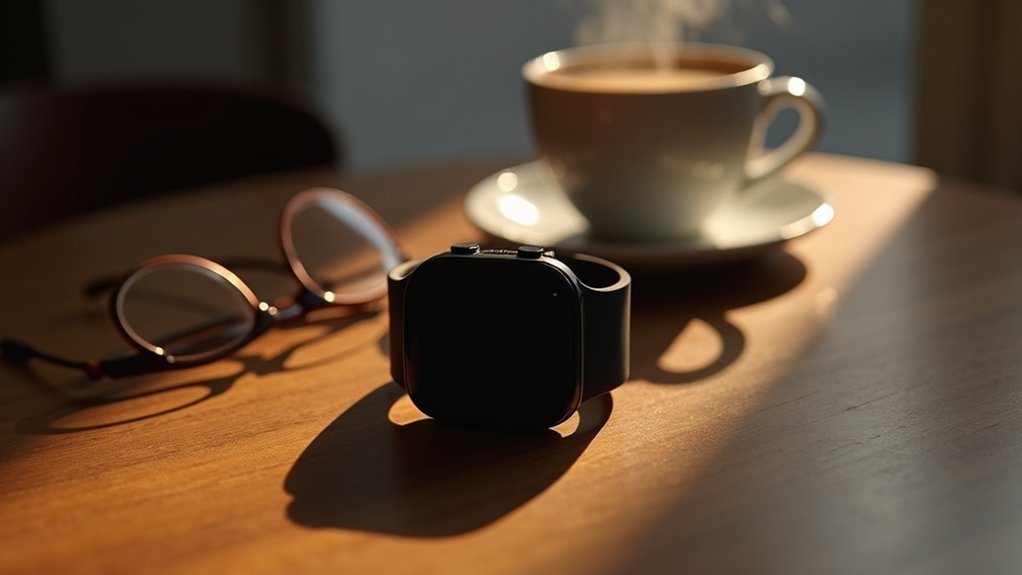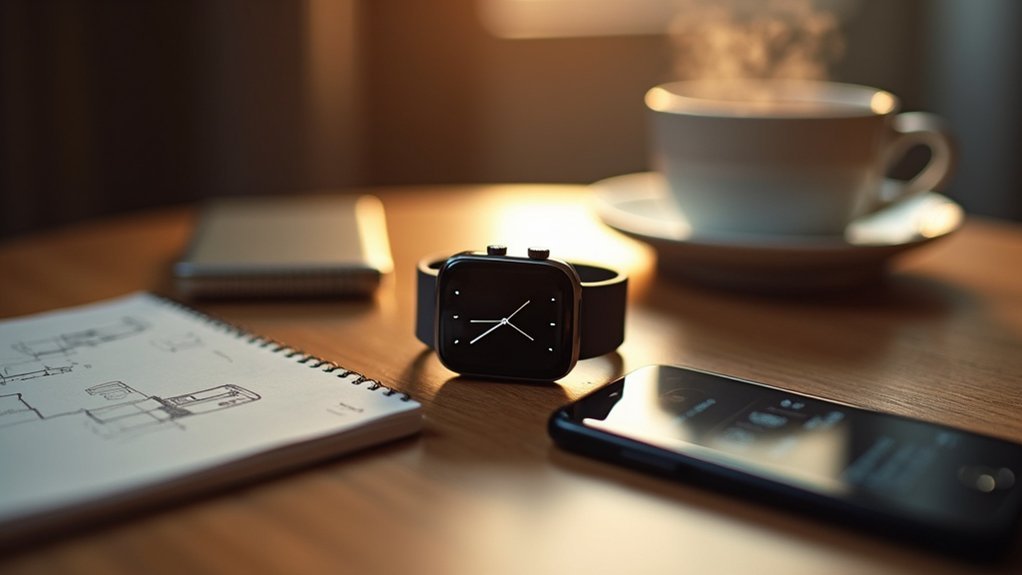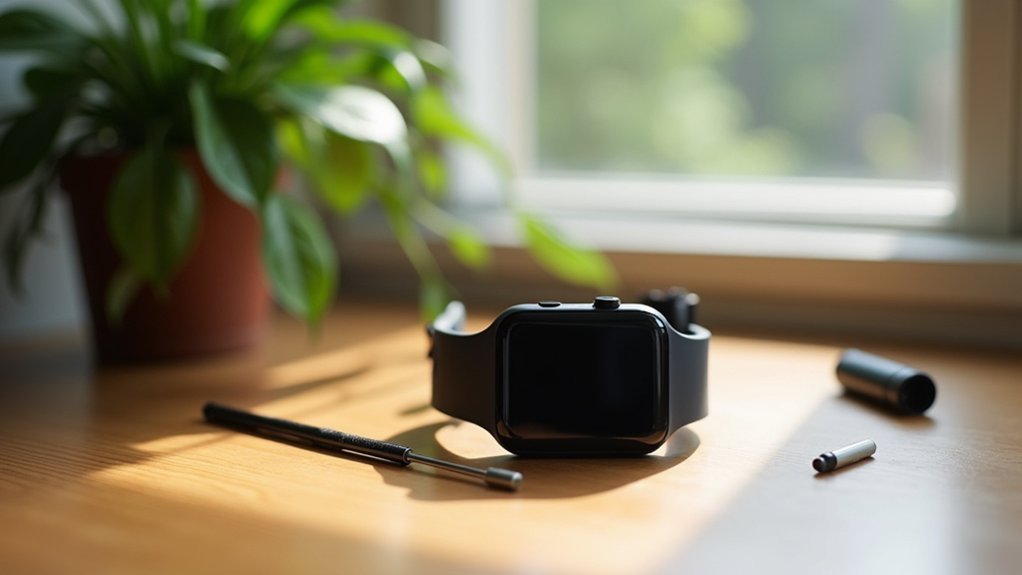You can dramatically extend your Wear OS battery life by disabling always-on display, which consumes over 25% of your power. Reduce screen brightness, shorten timeout to 10 seconds, and switch to simple watch faces without animations. Turn off unnecessary location services for apps that don’t need them, limit background processes, and adjust heart rate monitoring from continuous to periodic checks. Enable power-saving mode and manage Bluetooth connectivity strategically to optimize your watch’s performance throughout the day.
Disable Always-on Display to Save Power

Although the Always-on Display feature offers convenient at-a-glance information, it’s one of the biggest culprits behind Wear OS battery drain. AOD can consume more than 25% of your battery, depending on your watch face and settings.
To disable AOD, swipe down from your screen’s top, tap Settings, go to Display, and turn off Always-on Display. Your watch will now turn off the screen when not in use, greatly extending battery life.
Turning off Always-on Display through Settings > Display dramatically extends your Wear OS watch’s battery life by letting the screen rest.
You’ll need to wake your watch more frequently, but this trade-off delivers substantial power savings. If you prefer keeping AOD enabled, experiment with simpler watch faces to reduce battery impact. For developers testing their apps, it’s recommended to test with Always-on display turned off to ensure proper power efficiency optimization.
Disabling AOD remains one of the most effective power-saving strategies compared to other methods like brightness adjustment or notification management.
Optimize Screen Brightness and Timeout Settings
You’ll drastically improve your Wear OS battery life by optimizing how your screen behaves throughout the day.
Start by adjusting your brightness levels to match your environment—higher settings drain power faster, while lower levels extend usage time. For outdoor activities, consider using Sunlight Boost mode on compatible devices like the Pixel Watch 2 to enhance visibility without constantly maxing out regular brightness settings.
Don’t forget to configure your screen timeout and enable adaptive brightness to automatically handle these adjustments based on ambient lighting conditions.
Adjust Brightness Levels
Since your Wear OS watch’s display consumes the most battery power, adjusting brightness levels represents one of the most efficient ways to extend battery life. You can access brightness settings by swiping down from the top of your display and tapping the sun icon.
| Watch Type | Adjustment Method |
|---|---|
| Galaxy Watch | Slide finger along the arc |
| Other Watches | Tap + or – buttons |
| All Models | Use Settings app Display section |
Enable auto-brightness to automatically adjust based on ambient light conditions. This feature dims your screen in low-light environments, greatly reducing power consumption. You can also manually set custom brightness levels like 20%, 40%, or 60% for ideal visibility while conserving battery. For optimal battery efficiency, keep your brightness settings at or below 25% HSV scale whenever possible, as this significantly reduces power draw while maintaining adequate visibility.
Set Screen Timeout
After adjusting brightness levels, reducing your screen timeout duration provides another powerful method to preserve battery life on your Wear OS watch.
Most watches default to 15 seconds, but you can shorten this considerably. Open Settings on your watch, navigate to Display, then select Screen timeout. Choose a shorter duration like 10 or 5 seconds. This reduces unnecessary screen-on time, which conserves more battery than many other tweaks.
For maximum savings, disable Always-on Display entirely. You can also disable Tilt-to-Wake to prevent accidental screen activations, reduce animation effects, and silence watch sounds for additional battery conservation. Dark mode can further reduce power consumption on OLED screens by minimizing the energy needed to display bright colors.
Regularly review these settings and adjust the timeout based on your usage patterns for ideal results.
Enable Adaptive Brightness
While screen timeout controls how long your display stays active, adaptive brightness guarantees your watch uses only the necessary brightness level for current lighting conditions. This feature automatically reduces battery drain by preventing unnecessarily high brightness while maintaining ideal visibility.
How to Enable Adaptive Brightness
| Device Type | Navigation Path |
|---|---|
| Pixel Watch, TicWatch, OnePlus | Swipe down → Tap sun icon → Use +/- buttons |
| Galaxy Watch | Settings → Display → Adaptive brightness |
| Most Wear OS devices | Quick Settings → Brightness icon → Toggle auto |
| Alternative method | Settings → Display → Auto brightness |
| Troubleshooting | Settings → Apps → Device Health Services → Reset |
Adaptive brightness learns your preferences over time, automatically adjusting to different environments from bright sunlight to dark rooms, maximizing both visibility and battery efficiency. The feature employs ambient light sensor to continuously monitor surrounding light levels and make real-time adjustments accordingly.
Manage Background Apps and Services
Background apps and services represent one of the most significant sources of battery drain on Wear OS devices, often consuming power even when you’re not actively using your smartwatch.
You’ll want to identify and limit unnecessary background processes like Wi-Fi and Bluetooth services that continuously run. Access your watch’s settings to review which apps are running in the background and disable those you don’t need frequently.
Schedule data-intensive tasks like syncing and updates when your device is charging rather than during active use.
Take advantage of power management features like Doze mode, which reduces background activity when your watch is inactive. You can also adjust notification settings to prevent unnecessary wake-ups and customize service frequencies to optimize battery life based on your usage patterns. The Wear app’s battery menu provides limited insights into actual power consumption, with only about one-third of your battery drain being attributed to the services it displays.
Turn Off Unnecessary Location Services

Location services can silently drain your Wear OS battery as apps constantly ping GPS, Wi-Fi, and cellular radios to track your position.
You’ll save significant battery life by disabling location access for apps that don’t truly need it, since GPS is one of the most power-hungry features on your smartwatch. The frequency of location requests directly impacts how much power your device consumes, making it essential to limit unnecessary location polling.
Even switching from high-accuracy to balanced location mode can extend your battery throughout the day without sacrificing essential functionality.
Disable App Location Access
Although your Wear OS device relies on location services for many features, unnecessary location access by apps can severely drain your smartwatch’s battery throughout the day. You’ll need to review which apps have location permissions and disable access for those that don’t require it.
Navigate to your watch’s Settings, select Apps & notifications, then choose App permissions. Look for Location and review each app’s access level. Disable location for fitness trackers that sync with your phone, weather apps that can use your phone’s data, and social media apps that don’t need precise positioning.
Pay special attention to apps with location history enabled, as this feature is a common cause of excessive battery drain even when you think location services are properly configured.
| App Type | Location Need | Action |
|---|---|---|
| Fitness Apps | High | Keep enabled |
| Weather Apps | Low | Disable |
| Social Media | None | Disable |
This selective approach maintains functionality while preserving battery life.
Battery Savings From GPS
GPS sensors consume more battery power than any other location service on your Wear OS device, making targeted management essential for extending daily usage.
You’ll see remarkable battery improvements by switching from high accuracy mode to balanced power accuracy, which uses Wi-Fi and cell towers instead of constantly activating GPS hardware.
For background apps, choose low power mode to avoid GPS entirely while maintaining basic location functionality.
Reduce location request frequency by scheduling GPS activation only during active use rather than continuous tracking.
You can further optimize battery life by disabling Wi-Fi scanning when precise GPS isn’t needed and using no power mode for apps that can function with passive location data.
Sleep tracking apps can consume significant power when GPS location services run continuously, with some users reporting battery drain increases from 25% to over 50% during 8-hour periods.
These adjustments considerably reduce power consumption without sacrificing core functionality.
Reduce Push Notifications and App Alerts
Since your Wear OS watch receives notifications every 49 seconds on average, you’re dealing with constant interruptions that keep your device active and drain the battery. Most alerts come from instant messaging and emails, creating unnecessary wake-up sessions.
You can dramatically reduce battery drain by customizing your notification settings. Focus on receiving only critical alerts and filter out non-essential ones. Use Do Not Disturb mode during specific hours to prevent frequent wake-ups.
| Notification Type | Battery Impact |
|---|---|
| Instant Messages | High |
| Email Alerts | Medium |
| Social Media | High |
| News Updates | Low |
| Calendar Events | Medium |
Choose apps that send fewer alerts and disable gesture detection during non-essential times. These simple adjustments will greatly extend your battery life. Most users report that Bluetooth tethering typically results in about 3% battery usage when connected to their smartwatch.
Update Your Wear OS Software Regularly

After fine-tuning your notification settings, keeping your Wear OS software up to date represents another powerful way to combat battery drain. Regular updates include critical optimizations that improve power management and performance efficiency.
Regular software updates deliver critical power management optimizations that significantly reduce battery drain on your Wear OS device.
Wear OS 6, for example, delivers up to 10% better battery life through enhanced power optimizations compared to previous versions.
These updates also strengthen background app management, preventing unnecessary drain from apps running behind the scenes. You’ll benefit from improved memory management and processor efficiency optimizations that reduce power consumption.
Updates often introduce or enhance low power modes, giving you extended usage when needed. The latest Wear OS 5 reduces power consumption by 20% for marathon tracking compared to its predecessor.
Don’t forget that security patches maintain device stability, which directly impacts battery performance. Enable automatic updates or check regularly to make certain you’re running the latest version with all available battery-saving improvements.
Disable Bluetooth and Wi-Fi When Not Needed
While Bluetooth and Wi-Fi connections keep your smartwatch functional, they’re also silent battery killers that continuously drain power even when you’re not actively using them. You can strategically manage these connections to extend your battery life considerably.
| Connection Type | Best Usage Scenario | Battery Impact | Power-Saving Tip | Background Consumption |
|---|---|---|---|---|
| Bluetooth | Notifications, calls | Moderate | Enable for alerts only | Continuous scanning |
| Wi-Fi | App downloads, updates | High when active | Use during charging | Network searching |
| Both Active | Full functionality | Combined drain | Switch based on task | Double consumption |
| Both Disabled | Emergency mode | Minimal | Use sparingly | Nearly eliminated |
| Selective Use | Balanced approach | Optimized | Task-specific activation | Controlled usage |
Enable Bluetooth specifically for notifications and Wi-Fi for downloading apps, then disable them when unnecessary to reduce background energy consumption. Battery use drops to around 3% per hour with all features active, making selective connectivity management crucial for optimal performance.
Adjust Heart Rate Monitoring Settings
Heart rate monitoring transforms your Wear OS watch into a powerful health tracker, but this constant sensor activity can greatly drain your battery throughout the day.
By default, most devices continuously monitor your heart rate, which keeps sensors active even when you’re idle.
You can markedly improve battery life by adjusting monitoring intervals through your health or fitness app settings. Instead of continuous tracking, switch to periodic monitoring that checks your heart rate every few minutes.
Many devices also offer automatic adjustments based on your activity levels, activating more frequent monitoring during workouts while reducing it during rest periods.
Consider disabling heart rate monitoring entirely during low-activity periods or when battery conservation is your priority.
Choose Simple Watch Faces Over Complex Ones
Your watch face choice directly impacts battery life, with complex faces consuming considerably more power than simple alternatives.
Animated elements, multiple complications, and high refresh rates force your CPU and GPU to work harder, draining your battery faster throughout the day.
You’ll extend your Wear OS device’s battery life by selecting minimalistic faces with fewer moving parts and lower on-pixel ratios during ambient mode. Some users report that watch faces contribute up to 57% of their overnight battery usage, making this one of the most significant factors in overall battery performance.
Power Consumption Comparison
When you’re selecting a watch face for your Wear OS device, the complexity of your choice directly impacts battery performance. Simple watch faces with minimal complications can extend your battery life considerably compared to data-heavy alternatives that constantly refresh information.
Complex animations and high refresh rates drain power faster than static elements. You’ll notice better battery performance when you choose faces with fewer pixels and simpler color schemes.
Data-reliant complications increase power consumption because they require frequent background updates. Even hidden components can load unnecessarily and consume power if not optimized.
Media-rich watch faces with large, uncompressed images also demand more processing power. By selecting streamlined designs with essential features only, you’ll reduce screen updates and minimize the workload on your device’s processor. Third-party watch faces typically operate on the more power-hungry Wear OS system instead of the device’s energy-efficient RTOS, which explains why they consume significantly more battery than manufacturer-optimized options.
Optimal Face Selection
Three key factors determine how much your watch face impacts battery life: visual complexity, data frequency, and processing demands.
You’ll save significant power by choosing simpler designs with fewer complications. Each complication requires background data updates that continuously drain your battery.
Static elements consume far less energy than animations, so avoid watch faces with moving parts or frequent visual changes.
Set your update rate to refresh only when minutes pass rather than continuously renewing. Use faces with simpler color schemes and fewer colors to minimize screen power usage.
Turn off unnecessary sensors like gyroscopes when they’re not needed. Disable the always-on display feature for maximum battery savings.
You can customize most watch faces to remove unused features and reduce power consumption effectively. Google’s new Watch Face Format is specifically designed with power-saving features that help extend your smartwatch’s battery life significantly.
Enable Power Saving Mode Features
Since power-saving mode automatically adjusts your watch’s settings to extend battery life, you’ll want to enable it when your Wear OS device starts running low on juice.
Power-saving mode extends your Wear OS watch’s battery life by automatically adjusting settings when power runs low.
This feature disables power-hungry functions like always-on display and tilt-to-wake while dimming your screen and reducing performance to conserve energy.
To activate it, swipe down from your watch face and tap the gear icon. Navigate to Battery settings and select “Battery saver” or “Power saving.”
Most Wear OS watches, including Google Pixel Watch and Samsung Galaxy Watch series, automatically enable this mode when battery drops to 10%.
You’ll notice disabled animations, deactivated sensors, and reduced CPU usage.
While performance slows down, you’ll gain greatly extended battery life during critical moments. Many users have requested enhanced power-saving features through Modes and Routines to allow automatic triggering at specific times, such as midnight, for even better battery management.
Frequently Asked Questions
Why Does My Wear OS Battery Drain Faster in Cold Weather?
Cold weather reduces your battery’s chemical efficiency, making it deliver less power while your Wear OS device works harder to maintain functionality, causing faster drain and increased power consumption.
How Often Should I Calibrate My Wear OS Watch Battery?
You shouldn’t calibrate your Wear OS watch battery on a schedule. Only calibrate when you notice significant battery percentage jumps or erratic readings. Most users don’t need regular calibration unless problems arise.
Can Using Third-Party Watch Faces Cause More Battery Drain?
Yes, you’ll experience more battery drain with third-party watch faces. They’re less efficient than native ones, especially complex faces with animations or complications that constantly gather data from various sources.
Does Charging My Watch Overnight Damage the Battery Long-Term?
Charging your watch overnight won’t damage the battery since modern smartwatches have overcharging protection. However, keeping it at 100% for extended periods can slightly degrade long-term battery health.
Why Does My Battery Percentage Suddenly Drop or Jump Unexpectedly?
Your battery percentage jumps due to background apps draining power, system calibration errors, or Wear OS monitoring inaccuracies. Third-party apps like Spotify often cause sudden drops through excessive background activity.
In Summary
You’ve got all the tools to extend your Wear OS battery life considerably. Start with the biggest drains like always-on display and complex watch faces, then work through location services and unnecessary notifications. Don’t forget to adjust heart rate monitoring and use power saving mode when needed. You’ll notice longer battery life within days of implementing these changes consistently.





Leave a Reply